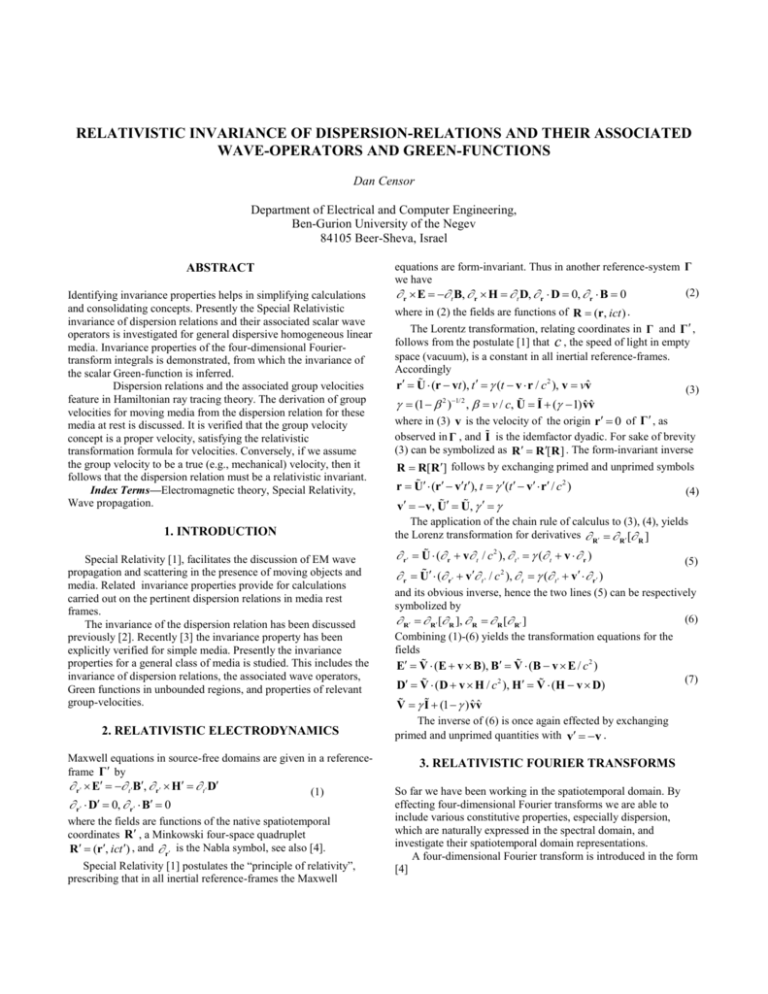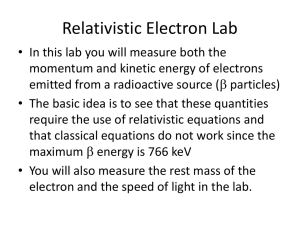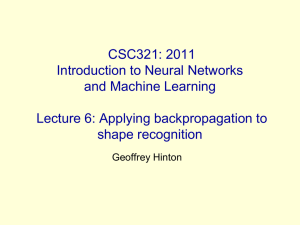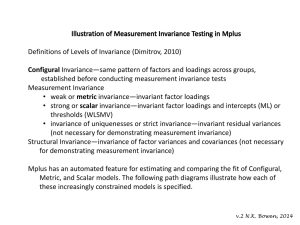IEEE-eilat-2008-invariance
advertisement

RELATIVISTIC INVARIANCE OF DISPERSION-RELATIONS AND THEIR ASSOCIATED WAVE-OPERATORS AND GREEN-FUNCTIONS Dan Censor Department of Electrical and Computer Engineering, Ben-Gurion University of the Negev 84105 Beer-Sheva, Israel ABSTRACT Identifying invariance properties helps in simplifying calculations and consolidating concepts. Presently the Special Relativistic invariance of dispersion relations and their associated scalar wave operators is investigated for general dispersive homogeneous linear media. Invariance properties of the four-dimensional Fouriertransform integrals is demonstrated, from which the invariance of the scalar Green-function is inferred. Dispersion relations and the associated group velocities feature in Hamiltonian ray tracing theory. The derivation of group velocities for moving media from the dispersion relation for these media at rest is discussed. It is verified that the group velocity concept is a proper velocity, satisfying the relativistic transformation formula for velocities. Conversely, if we assume the group velocity to be a true (e.g., mechanical) velocity, then it follows that the dispersion relation must be a relativistic invariant. Index Terms—Electromagnetic theory, Special Relativity, Wave propagation. where in (2) the fields are functions of R (r, ict ) . The Lorentz transformation, relating coordinates in Γ and Γ , follows from the postulate [1] that c , the speed of light in empty space (vacuum), is a constant in all inertial reference-frames. Accordingly r U (r vt ), t (t v r / c 2 ), v vvˆ ˆˆ (1 2 )1/2 , v / c, U I ( 1) vv where in (3) v is the velocity of the origin r 0 of Γ , as (3) observed in Γ , and I is the idemfactor dyadic. For sake of brevity (3) can be symbolized as R R [R ] . The form-invariant inverse R R[R ] follows by exchanging primed and unprimed symbols r U (r vt ), t (t v r / c 2 ) v v, U U, (4) The application of the chain rule of calculus to (3), (4), yields the Lorenz transformation for derivatives R R [ R ] 1. INTRODUCTION Special Relativity [1], facilitates the discussion of EM wave propagation and scattering in the presence of moving objects and media. Related invariance properties provide for calculations carried out on the pertinent dispersion relations in media rest frames. The invariance of the dispersion relation has been discussed previously [2]. Recently [3] the invariance property has been explicitly verified for simple media. Presently the invariance properties for a general class of media is studied. This includes the invariance of dispersion relations, the associated wave operators, Green functions in unbounded regions, and properties of relevant group-velocities. 2. RELATIVISTIC ELECTRODYNAMICS Maxwell equations in source-free domains are given in a referenceframe Γ by r E t B, r H t D r D 0, r B 0 equations are form-invariant. Thus in another reference-system Γ we have (2) r E t B, r H t D, r D 0, r B 0 (1) where the fields are functions of the native spatiotemporal coordinates R , a Minkowski four-space quadruplet R (r, ict ) , and r is the Nabla symbol, see also [4]. Special Relativity [1] postulates the “principle of relativity”, prescribing that in all inertial reference-frames the Maxwell r U ( r v t / c 2 ), t ' ( t v r ) r U ( r v t ' / c 2 ), t ( t ' v r ) (5) and its obvious inverse, hence the two lines (5) can be respectively symbolized by (6) R R [ R ], R R [ R ] Combining (1)-(6) yields the transformation equations for the fields E V (E v B), B V (B v E / c 2 ) D V (D v H / c 2 ), H V (H v D) (7) ˆˆ V I (1 ) vv The inverse of (6) is once again effected by exchanging primed and unprimed quantities with v v . 3. RELATIVISTIC FOURIER TRANSFORMS So far we have been working in the spatiotemporal domain. By effecting four-dimensional Fourier transforms we are able to include various constitutive properties, especially dispersion, which are naturally expressed in the spectral domain, and investigate their spatiotemporal domain representations. A four-dimensional Fourier transform is introduced in the form [4] f (R ) q (d 4K ) f (iK )eiK R , K R k r t (8) d 4 K dk x dk y dk z d (i / c), K (k , i / c), q (2 ) 4 where in (8) f ( R ) is an arbitrary scalar function, and f (iK ) indicates the corresponding transformed function, K is the spectral domain Minkowski four-vector. The corresponding inverse Fourier transformation is therefore written as f (iK) (d 4 R) f (R)eiKR , d 4 R dx dy dz d (ict ) (9) q (d 4 K ) p (iK ')eiK R p( R) (d 4 R) p(R)e iK R p (iK ') and its analog f (R) f (R[R]) p(R) f ( R )q (d 4 K )eiK R f ( R ) ( R ) approximated by a polynomial in iK . The function f (iK ) and the associated operator function f ( R ) are simply related by a formal exchange iK R . Thus far all mention of Minkowski four-vectors involved notation only. At this point the relativistic import of Minkowski’s fourspace is included. Accordingly the inner product of two Minkowski four-vectors is an invariant, hence for two referenceframes Γ and Γ we have in (8)-(10) (11) K R k r t K R k r t In studies discussing Special Relativity where the Minkowski four-space is not used (11) is still needed, usually referred to as the “phase invariance principle”, e.g., see [9], p. 601. It is noted that Einstein [1] assumed (13) tacitly, omitting its postulational status. Substituting R R [R ] from (3) into (11) yields the Lorentz transformation for the spectral parameters K K [K ] and its inverse K K[K ] k U (k v / c ), ( v k ) 2 (12) k U (k v / c 2 ), ( v k ) respectively. In (12) the formulas for k , k , are referred to as the Relativistic Fresnel Drag Effect, the corresponding formulas for , , are referred to as the Relativistic Doppler Effect. Corresponding to (5), (6) we can derive from (12) four-vectors for derivatives in the spectral domain [4] K ( k , -ic ), K ( k , -ic ) k ' U ( k v ), ' ( v k / c 2 ) (13) k U ( k ' v ' ), ( ' v k ' / c 2 ) Exploiting (6), (13), the dyadics (matrices) K K ' , R R , respectively, are constructed. The associated Jacobian determinants involved in changing variables in multiple integrals. The value of the Jacobians in the present case is unity, hence we have d 4 K ' det K K ' d 4 K d 4 K d 4 R det R R d 4 R d 4 R (14) From (11), (14), it follows that (8), (9), can be rewritten in the form (16) 4. DISPERSION RELATIONS AND WAVE OPERATORS IN MEDIA AT-REST (10) describing the delta-function expansion of f ( R ) . This method works well for slowly varying functions f (iK ) which can be (15) f (iK ) f (iK[K ']) (d 4 R) f (R[R ])e iK R f (iK ) f (iK [K ]) p(iK ) Exploiting the properties of the exponential, (8) can be formally recast [4, 6, 7] as f (R ) q (d 4 K ) f (iK )eiK R q (d 4 K ) f ( R )eiK R f (R ) f (R[R]) q (d 4 K ) f (iK[K '])eiK R Thus far no medium has been assumed, hence Γ has no priority over Γ . Henceforth Γ will be the reference-frame for media atrest. A quite general class of constitutive relations is characterized in the spectral domain by D(K ') α(iK ') E(K ') β(iK ') H(K ') (17) B(K ') γ (iK ') H(K ') δ(iK ') E(K ') with constitutive dyadics α, β, γ , δ , which in general are dispersive, i.e., depending on the spectral coordinates K ' . Strictly speaking, expressions such as (17), involving a product of terms, are expressed in the spatiotemporal domain in terms of four-fold convolution integrals [7]. Such integrals extend over the entire spatiotemporal domain. Assuming that a local technique as in (10) is applicable, (17) is substituted in the spectral integral (10) and iK R is effected in α, β, γ , δ , which are then taken outside the integral sign. What remains are the four-dimensional Fourier transforms for the fields (10), finally yielding in the spatiotemporal domain D(R) α ( R ) E(R) β( R ) H(R) B(R) γ ( R ) H(R) δ( R ) E(R) In the spectral domain (1) takes the form kˆ E(K ') B(K '), kˆ H(K ') D(K '), kˆ k / | k | where in (19) the superfluous r equations are omitted. (18) (19) Combining (17) with (19) provides a determinate system of six scalar homogeneous equations. Eliminating B and D reduces the number of scalar homogeneous equations and Cartesian components of the field vectors E, H , to six, taking the form φ E(K ) γ H(K ) 0, ψ H(K ) α E(K ) 0 φ φ(iK ) kˆ I δ, ψ ψ(iK ) kˆ I β (20) Combining E, H , into a single six-vector M , (20) is recast as φ(iK ) γ (iK ) E(K ) α(iK ) ψ(iK ) H(K ) G(iK ) M(K ) 0 (21) The condition of non-triviality prescribes that the determinant of G vanishes (22) det[G (iK )] G(iK ) 0 The scalar G in (22) is referred to as the dispersion relation. An equivalent derivation of G 0 follows from (21) by successively eliminating unknowns. The last irreducible equation includes any one of the six Cartesian field components denoted by M . Therefore (23) G(iK ) M (K ) 0 Clearly M 0 implies G 0 . We can also write (23) as (24) G(iK )M(K ) 0 Applying to (23) the four-dimensional integral and implementing the technique (10) yields the spatiotemporal domain scalar wave equation q (d 4 K )M(K )G(iK )eiK R G( R )q (d K )M(K )e 4 iK R (25) G( R )M(R) 0 where in (25) M ( R ) is the spatiotemporal domain Fouriertransformed function associated with the spectral domain M(K ) . It follows that G( R ) is the wave operator, applicable to all six Cartesian field components. In Γ the medium is observed in motion. The pertinent Maxwell equations are now given by (2). When it comes to constitutive relations, our aim is not to try and provide transformations for the constitutive dyadics α, β, γ , δ , (18) per se, as attempted elsewhere [10-13], but rather to provide relations between fields in Γ , which will render the system of equations determinate, as given for Γ in (20). To this end we use Minkowski’s theory [14], also discussed, with some historical notes, by Sommerfeld [15]. Minkowski’s approach is to assume the constitutive relations as given, characterizing the medium in question in its rest frame Γ , i.e., (18) in our case. Substituting (7) in (18) yields the Minkowski relations for the present case, in the spectral domain in Γ D(K ) v H(K ) / c 2 α v (iK ) (E(K ) v B(K )) β v (iK ) (H(K ) v D(K )) (28) (29) v ψ ψ (iK ) kˆ I v I / c 2 β v μ, μ I v kˆ I Once again we have a system of six scalar homogeneous equations in terms of the six Cartesian components of the field vectors E, H . The analog of (21) is now φ(iK ) γ v (iK ) μ(iK ) E(K ) α (iK ) μ(iK ) H (K ) ψ (iK ) v G (iK ) M(K ) 0 (30) leading to the analogs of (22)-(25) det G(iK ) G(iK ) 0 G(iK )M(K ) 0, G( R )M(R) 0 (31) With this we finish the derivation of the dispersion relations, and move on to discuss the problem of relativistic invariants. 5. DISPERSION RELATIONS AND WAVE OPERATORS IN MOVING MEDIA B ( K ) v E( K ) / c 2 kˆ E(K ) B(K ), kˆ H (K ) D(K ), kˆ k / | k | Combining (28) with (27) yields the analog of (20) φ E(K ) γ v μ H (K ) 0, ψ H (K ) α v μ E(K ) 0 φ φ(iK ) kˆ I v I / c 2 δ μ (26) γ v (iK ) (H(K ) v D(K )) δ v (iK ) (E(K ) v B(K )) 6. RELATIVISTIC INVARIANCE PROPERTIES Recognizing invariance properties is an important part of any mathematical physics discipline, usually leading to simplified manipulation and notation, much like solving a complicated differential equation by implementation of a clever change of variable. Incorporating (28) and (7) in (24) yields G(iK)M(K) G(iK)V μ M(K ) (32) V μ [G(iK )M(K )] 0 where in (32) G and V μ have been interchanged. This is feasible because of the scalar nature of G . Inasmuch as V, μ, M , are in general non-vanishing, it follows that (33) G(iK)M(K ) G(iK[K ])M(K ) G(iK )M(K ) 0 where by virtue of the unprimed fields M , the dispersion-relation G(iK ) 0 applies in the Γ reference-frame. By comparing (31), ηv (iK ) V 1 η(iK [K ]) V, V 1 U / , η α, β, γ , δ (33), it becomes clear that In (26) the modified constitutive dyadics are created by pre-, post-, multiplication of the original dyadics by V 1 , V , respectively. The modified constitutive parameters are initially functions of iK . By substitution of K K [K ] from (12), the modified constitutive dyadics are obtained as functions of the argument iK . We have already discussed the fact that the fields and not their arguments are the decisive factor as to whether observations, i.e., measurements, are performed in Γ or Γ . In (26) we are dealing with unprimed fields, therefore we are residing in reference frame Γ . The analog of (18) is now i.e., the Γ dispersion-relation G uniquely determines the Γ counterpart G G 0 . Expressing either in terms of K or K is simply a matter of convenience. For the wave operator it follows in a consistent manner D(R ) v H(R ) / c 2 α v ( R ) (E(R ) v B(R )) β v ( R ) (H(R ) v D(R )) B(R ) v E(R ) / c 2 (27) G(iK) G(iK[K ] G(iK ) G(iK ) 0 G( R )M(R) G( R [ R ])M( R[ R ]) G( R )M(R[R ]) V μ [G( R )M ( R )] G( R ) G( R [ R ]) G( R ) G ( R ) hence the scalar wave operators are invariants as well, and the consequent scalar wave equations are shown in (35). The dispersion-relation invariance (34) can also be derived in a slightly different manner: starting with (21), exploiting the transformation shown in (32), and comparing to (30), we have G(iK) M(K) G(iK ) V μ M(K ) D(K ) v H(K ) / c G(iK [K ]) V μ M(K ) G(iK ) M(K ) 0 Instead of (19) we have its Γ analog by simply removing apostrophes (35) V μ [G ( R )M (R )] 0 γ v ( R ) (H(R ) v D(R )) δ v ( R ) (E(R ) v B(R )) 2 (34) (36) i.e., the dyadics multiplying arbitrary non-vanishing fields M are in general equal and vanishing (37) G(iK ) V μ G (iK ) 0 Invoking the theorem that the determinant of a product of matrices is the product of the individual determinants, and in view of det[V] 0, det[μ] 0 , we derive (34) once more. An explicit calculation of the dispersion-relation invariance in simple media has been carried out in [3]. For an unbounded region in the rest-frame Γ , the appropriate scalar Green function is defined by the inhomogeneous wave equation (38) G( R ) g (R) (R) 0 together with some causality condition or radiation condition [16], in order to distinguish waves emanating from the singularity R 0 , from the case of (mathematically possible) waves converging onto the singularity from infinity. The definition (38) is slightly different from the widely used G( R ) g (R) (R) . Also note that usually instead of R we have R ρ with some fixed ρ , such that Rρ R . All this does not affect the generality of our argument. Applying to (38) the Fourier transform (10) in Γ , we obtain G( R ) g (R) (R) q (d 4K)[G(iK ') g (K ') 1]eiKR 0 (39) q (d 4K) g (K ')eiKR g (R) q (d 4K)G1 (iK ')eiKR (41) where we do not address some finer points regarding the convergence of the integral [16]. Suffice it to say that the zeroes of G become poles in (41), determining g in the spatiotemporal domain. The invariance of the dispersion relation (34), and the properties of the four-fold integrals discussed above, e.g., (15), prescribe for (41) g (R) q (d 4K )G1 (iK ')eiK R g (R[R ]) q (d K )G (iK )e 4 1 iK R v g k (k ) k G(iK ) / G(iK ) (42) g (R) i.e., having been given g (R) , by substituting R [ R ] we obtain g (R) g (R[R ]) g (R) , and thus the invariance of the unbounded domain scalar Green function is established. In electromagnetics, g , g , can be associated with Cartesian components of the fields. 7. THE GROUP VELOCITY IN Γ AND Γ One reason for deriving dispersion relations is to trace rays in various media, e.g., see [4, 16-19] for the Hamiltonian ray-tracing theory. By definition, rays are the paths whose tangent at any point is parallel to the group velocity direction at that point. It is tempting to think of rays as geometrical entities, and assume that in a moving medium Γ we observe the same rays of (43) vg k (k ) k G(iK) / G(iK) where in (43) , , are relevant if the dispersion-relations can be recast as G (iK ) (k ) 0, G(iK ) (k ) 0 in Γ, Γ , respectively. Usually it is simpler to evaluate G (22) in the medium restframe Γ than to directly solve for G (31) in Γ . Hence the invariance G G in (34) and the transformations (13) are exploited to calculate v g in (43) v g k G(iK ) / G(iK ) [U ( k v )G(iK )]/[ ( v k / c 2 )G(iK )] implying in the spectral domain (40) g (K ') 1/ G(iK ') Applying the integration operator in (39) to (40) yields in the spatiotemporal domain q (d 4 K )G1 (iK '[K ])eiK R the medium at rest in Γ , except that the ray paths are now moving, subject to the Lorentz transformation (3). This is a misconception. The moving medium in Γ behaves as a different medium, and rays in this medium will be governed by the appropriate dispersion relation (31). However, the group velocity does behave as a proper velocity, i.e., u dr / dt , u dr / dt , in Γ, Γ , respectively, and is thus subject to the relativistic transformation of velocities, as demonstrated below. Group velocities are computed from the relevant dispersion relations according to (44) The relativistic transformation formulas relating velocities in Γ, Γ , respectively, follow from (3), (4). Upon taking differentials and dividing, we obtain u U (u v) /( (1 v u / c 2 )) u U (u v) /( (1 v u / c 2 )) Identifying u v g , u vg and substituting from (43) into (45) (45), then exploiting (13) and the invariance (34), verifies that group velocities are velocities proper, satisfying the relativistic transformation of velocities (45) vg U ( v g v) /( (1 v v g / c 2 )) [U ( k v )G (iK )]/[ ( v k / c 2 )G(iK )] k 'G(iK ) / 'G(iK ) (46) Conversely, if we assume that the group velocity is a true velocity, in the sense of mechanics of particles, then it follows that the dispersion-relation is a relativistic invariant. 8. SUMMARY AND CONCLUDING REMARKS In the present study the relativistic invariance properties of dispersion-relations are investigated. The media chosen are very general: dispersive, homogeneous, bi-anisotropic (in a very broad sense), and linear. The invariance of the dispersion-relations in arbitrary inertial reference systems has been demonstrated. The invariance properties of the four-dimensional Fourier-transform integrals facilitated the discussion of the invariance of the associated wave operators. Furthermore, the properties of the integrals enabled us to show that the scalar Green functions associated with the dispersion-relations also constitute relativistic invariants. Dispersion-relations are needed for the implementation of the Hamiltonian ray tracing theory. At the heart of this theory is the fact that rays are paths whose tangent at any point is parallel to the group-velocity at that point. Exploiting the invariance G G , it has been shown that the group-velocity in the moving medium, as observed in Γ , can be derived from the medium’s rest-frame dispersion-relation in Γ . This offers a simpler method for computing the group-velocity. While ray paths are not geometrical entities subject to the spatiotemporal Lorentz transformation, the group-velocities computed in Γ, Γ , do obey the relativistic velocity-addition formula, subject to the invariance G G . Conversely, if the transformation formula for velocities is assumed, it follows that the invariance G G must exist. 9. ACKNOWLEDGMENT I am grateful to Dr. Martin W. McCall, Department of Physics, The Blackett Laboratory, Imperial College London, for reading the article and making many helpful comments. Any errors are of course my responsibility. 10. REFERENCES [1] A. Einstein, “Zur Elektrodynamik bewegter Körper”, Ann. Phys. (Lpz.), vol. 17, pp. 891-921, 1905; English: “On the Electrodynamics of moving bodies”, in ThePrinciple of Relativity, Dover, 1952. [2] D. Censor, “Dispersion Equations in Moving Media”, Proceedings IEEE, vol. 68, pp. 528-529, 1980. [3] M.W. McCall and D. Censor, “Special Relativity education and mathematical tools: waves in moving media”, Am. J. Physics, vol. 75, pp. 1134-1140, 2007. [4] D. Censor, “Application-oriented relativistic electrodynamics (2)”, PIER, Progress In Electromagnetics Research, vol. 29, pp. 107–168, 2000. [5] J.A. Stratton, Electromagnetic Theory, McGraw-Hill, 1941. [6] I.V. Lindell, Methods for Electromagnetic Field Analysis, Oxford Science publications, 1992. [7] D. Censor and T. Melamed, "Volterra differential constitutive operators and locality considerations in electromagnetic theory", PIER- Progress in Electromagnetic Research, vol. 36, pp. 121-137, 2002. [8] D. Censor, “Constitutive relations in inhomogeneous systems and the particle-field conundrum”, PIER--Progress In Electromagnetics Research, vol. 30, pp. 305-335, 2001. [9] J. A. Kong, Electromagnetic Wave Theory, Wiley, 1986. [10] E.J. Post, Formal Structure of Electromagnetics, Dover, 1997. [11] H. Hebenstreit, “Constitutive relations for moving plasmas”, Z. Naturforsch. A, vol. 34a, pp. 147-154, 1979. [12] H. Hebenstreit, “Calculation of covariant dispersion equations for moving plasmas”, Z. Naturforsch. A, vol. 34a, pp. 155-162, 1979. [13] H. Hebenstreit and K. Suchy, “Polarization relations and dispersion equations for anisotropic moving media”, Z. Naturforsch. A, vol. 34a, pp. 1147-1157, 1979. [14] H. Minkowski, “Die Grundgleichungen für die elektromagnetische Vorgänge in bewegten Körpern”, Göttinger Nachrichten, pp. 53-116, 1908. [15] A. Sommerfeld, Electrodynamics, Academic Press, 1964. [16] L.B. Felsen and N. Marcuvitz, Radiation and Scattering of Waves, Prentice-Hall, 1973. [17] J.M. Kelso, Radio Ray Propagation in the Ionosphere, McGraw-Hill, 1964. [18] D. Censor, “Application-oriented ray theory” International. J. Electrical. Eng. Education, vol. 15, pp. 215-223, 1978. [19] J. Molcho and D. Censor, “A simple derivation and an example of Hamiltonian ray propagation”, Am. J. Phys, vol. 54, pp. 351-353, 1986.









